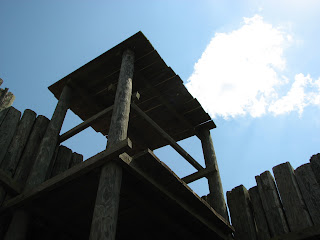The trip to Andersonville Civil War Prison was three and a half hours long - one way. It was a good trip. We took in the beautiful Georgia
So.....here I am using my Android navigation tool........
..... and getting ticked off that the navigation lady had it wrong on a portion of the trip because of a rebuilt road. That little triangle marker denoting our location was going off the little android map in these parts and the nice English sounding lady was wanting us to make a u-turn. "No!, you are wrong", I barked at her. We prevailed and soon she ...errr...we were back on track.
I wonder how the war would have turned out if either side had one of these bad boys?
I felt better. I didn’t whine anymore.I also started to think about the topography of this area and how Andersonville seemed to be tucked in the middle of nowhere......how DID they find these places back in the day? I guess it was the right place for an open prison.
We wanted to be sure we went to Andersonville town proper, the prison site and the cemetery. We did see all three.
The Civil War Town of Andersonville was small, most places were closed because of the Easter holiday. . I did take time to act like a tourist and get a picture of me acting like a tourist,
What I found most interesting in the town was a monument dedicated to Henry Wirz the prison commandant in 1864.
The Georgia Division and the United Daughters of the Confederacy proposed a resolution at its 1905 convention to erect a monument in memory of Henry Wirz. The U.D.C. prevailed in this battle and the monument was erected at the prison site in Andersonville on May 12, 1908.
The monument states:
The Front of the Monument
"In memory of Captain Henry Wirz, C.S.A. Born Zurich, Switzerland, 1822. Sentenced to death and executed at Washington, D.C., Nov. 10, 1865.
To rescue his name from the stigma attached to it by embittered prejudice, this shaft is erected by the Georgia Division, United Daughters of the Confederacy."
On the Second Side
"Discharging his duty with such humanity as the harsh circumstances of the times, and the policy of the foe permitted, Captain Wirz became at last the victim of a misdirected popular clamor.
He was arrested in time of peace, while under protection of a parole, tried by a military commission of a service to which he did not belong and condemned to ignominious death on charges of excessive cruelty to Federal prisoners. He indignantly spurned a pardon, proffered on condition that he would incriminate President Davis and thus exonerate himself from charges of which both were..."
"As we entered the place, a spectacle met our eyes that almost froze our blood with horror, and made our hearts fail within us. Before us were forms that had once been active and erect;—stalwart men, now nothing but mere walking skeletons, covered with filth and vermin. Many of our men, in the heat and intensity of their feeling, exclaimed with earnestness. "Can this be hell?" "God protect us!" and all thought that He alone could bring them out alive from so terrible a place. In the center of the whole was a swamp, occupying about three or four acres of the narrowed limits, and a part of this marshy place had been used by the prisoners as a sink, and excrement covered the ground, the scent arising from which was suffocating. The ground allotted to our ninety was near the edge of this plague-spot, and how we were to live through the warm summer weather in the midst of such fearful surroundings, was more than we cared to think of just then."
........Many states were represented. The area today is marked by white poles signifying the boundaries of the prison
Water or lack of water was the major problem. A branch of Sweetwater Creek, called Stockade Branch, flowed through the prison yard and was the only source of water for most of the prison. It was used for everything, so you can only imagine. Dysentery, scurvy, malaria, and exposure were rampant.
It is said that a deafening noise like thunder or an earthquake shook the earth around the prison one day, and a stream of water burst forth from the torn ground. They considered this phenomenon a providential act of God and so the stream of water was called Providence Spring.
There is a stone house that was erected at the site in 1901,
Inscription is on the wall states: "The Prisoners' cry of thirst rang up to Heaven; God heard, and with His thunder cleft the earth and poured his sweet water came rushing here." On another side of this house is the inscription: "God smote the hillside and gave them drink, August 16, 1864.
The Cemetery:
Nothing I say can add anything to what the rows and rows of headstones are telling us..........
I did what most do on hallowed grounds such as these. I was quiet and respectful and reflected on their lives and their respect for country. May they all rest in peace.
I often wonder what these Civil war combatants and POW's would think if they could see the USA
If only these men could talk.
More photos from the trip:












































